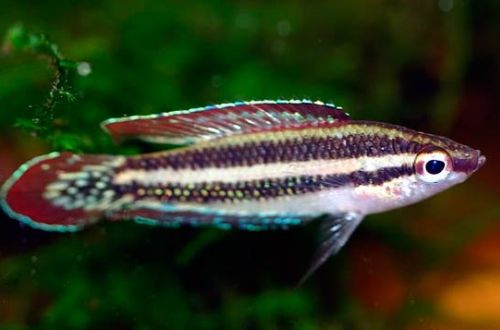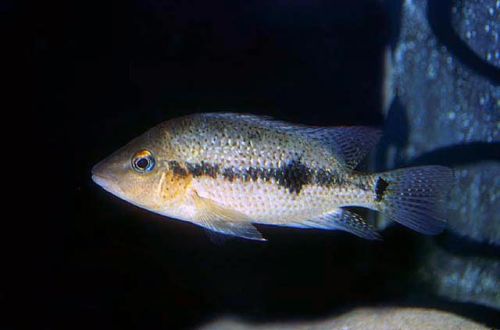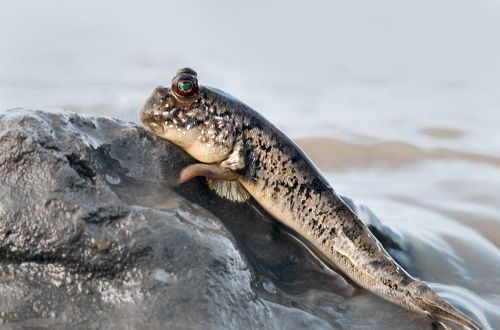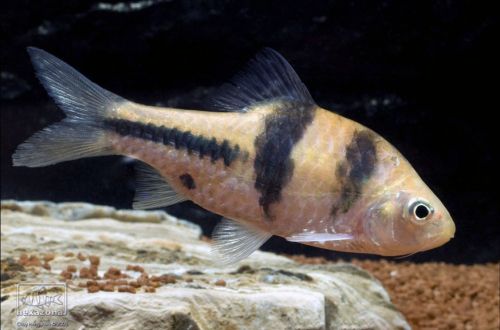
Parosfromenus fifteenth
Parosfromenus fifteenth or Kupanus fifteenth, scientific name Parosphromenus quindecim, belongs to the Osphronemidae family. The name, so unusual at first glance, is simply explained by the structure of the dorsal fin. Unlike most relatives, this species has 14–15 distinct rays on the dorsal fin, rising above the edge like spikes. It is quite rare for sale, besides it is difficult to maintain, therefore it is not recommended for beginner aquarists.

Contents
Habitat
It comes from Southeast Asia with the Indonesian part of the island of Borneo. It is found in the province of East Kalimantan. Inhabits swamps and wetlands of rivers under the canopy of dense tropical forest. In nature, fish live among numerous snags and plant debris (fallen leaves, snags, tree roots) in low light conditions. Dense crowns of trees let in little light, and the water has a rich brown color due to the high concentration of humic and tannins resulting from the decomposition of organic vegetation.
Brief information:
- The volume of the aquarium – from 40 liters.
- Temperature – 22-28°C
- Value pH — 3.0–6.5
- Water hardness – 1–5 dGH
- Substrate type – any dark
- Lighting – subdued
- Brackish water – no
- Water movement – little or no
- The size of the fish is about 4 cm.
- Food – live or frozen food
- Temperament – peaceful
- Content – in a group of relatives or with other small species
Description
Adults reach a length of about 4 cm. The fish have a striped body pattern of alternating light and dark horizontal stripes. In males, the base and edge of the fins are bluish, and the area between them is red. The area at the beginning of the tail is black with turquoise flecks. During the breeding season, the coloration becomes more intense. Females are noticeably more modestly colored, the main color is pale yellow.
Food
In a home aquarium, they feed mainly on live food (bloodworms, daphnia, brine shrimp, mosquito larvae). Similar frozen foods can also be part of the diet. Dry food is usually not accepted.
Maintenance and care, arrangement of the aquarium
The optimal size of the aquarium for one or two fish starts from 30-40 liters. In the design, it is necessary to provide for many shelters. A good choice would be natural driftwood, thickets of living plants. At the bottom, you can put a layer of dried leaves of some trees, previously soaked so that they do not float. The lighting is subdued. Clusters of floating plants will provide additional shading.
When keeping Parosfromenus fifteenth, special attention should be paid to the hydrochemical composition of water. Fish need very low pH and dGH, so water treatment may require a reverse osmosis plant or traditional soft water methods. It is worth noting that the use of leaves will make it possible to give water a chemical composition similar to that in which this species lives in nature, due to the release of tannins by them.
Ensuring a stable aquatic environment depends on the smooth operation of the equipment, in particular the filtration system, as well as on the regularity of the obligatory aquarium maintenance procedures: timely removal of organic waste (food residues, excrement) and weekly replacement of part of the water (10–15% of the volume) with fresh. Filtration should not be too intense to avoid internal flow. In some cases, a simple airlift filter with a sponge is quite enough.
Behavior and Compatibility
Males compete with each other for the attention of females, but it does not come to fierce rivalry, like in related betta fighting fish. If there are enough shelters, then several males can be together in a company with females. As compatible species, it is worth choosing calm fish of a similar size from among small cyprinids, for example, parsing. You should not settle together different types of Kupanus in order to avoid the appearance of hybrid offspring.
Breeding / breeding
A suitable environment (water composition) and a balanced diet increase the likelihood of spawning. With the onset of the breeding season, the male occupies an area at the bottom of the aquarium in the center of which is some suitable shelter where the clutch will be created. Having formed a temporary pair with the female, the fish begin the mating dance. During spawning, the fertilized eggs are placed in a shelter, then the female swims away, and the male remains to guard the clutch. He takes care of his offspring until the fry begin to swim on their own, which takes about a week. After that, parental instincts fade away.
Fish diseases
A well-established biological system, a balanced diet and the absence of stressful situations (for example, being chased by aggressive fish) are the best guarantee of maintaining health. When the first signs of an illness appear, first of all, attention should be paid to these three factors, perhaps there was a deviation in one of them. As a rule, solving the problem leads to self-healing. However, if the immune system fails, you will have to resort to medical treatment. Read more about symptoms and treatments in the Aquarium Fish Diseases section.





